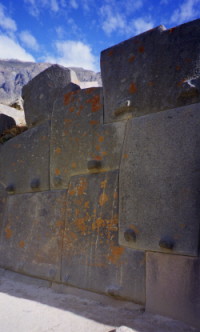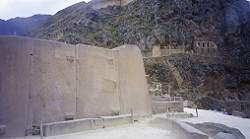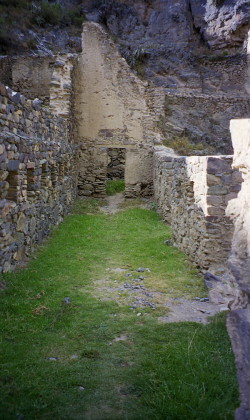 Photo.
Photo. The
megalithic wall at the pre-Inca site of Ollantaytambo. © Travel
Explorations.
The purpose of the construction
Ollantaytambo is
located at the northern end of the Sacred Valley. The citadel served both as a
temple and a fortress. At some time unknown, and for reasons unknown, the
amazing building work stopped. If we knew the Inca's plan from this period, we
could probably have some ideas about how it had looked if they had carried out
their ambitious project.
Ollantaytambo is a town in the Sacred Valley of the Incas near Cuzco in the
Southern Sierra region of Peru. This is where the Incas retreated after the
Spanish took Cuzco. Much of the town is laid out in the same way as it was in
Inca times.
Terraces
The huge and steep terraces that form
the outer defences of the fortress, successfully repelled a Spanish attack in
1536. Actually Ollantaytambo was not meant to be a fortress, but rather an
agricultural, religious and administrative centre.
I wanted so much to admire the big stones on the top of the mountain and the
great curved terraces in the middle of the mountain. It was a hard to climb the
steps under the hot sun. The entry into Ollantaytambo is in itself interesting.
There is a set of terraces leading up the mountainside and from the top there is
a wonderful view of the valley.
To the left of these terraces are the principal religious structures,
including the famous unfinished Temple of the Sun. It has been made of enormous
slabs of pink rhyolite that were quarried on a mountain opposite the site, and
then transported down this mountain, across a valley and a river, and so the way
up to the top of the mountain in Ollantaytambo.
Photo. Incredible stone work by the Incas.
How have they transported and shaped these huge stones?
© Travel Explorations. |
 |
Astronomical observations and solar clock
The
site also features beautiful fountains, a "Temple of the Condor," and numerous
rocks and stones with a variety of indentations and grooves that may have been
used for astronomical observations. The most remarkable of these is a vertical
rock face with protruding knobs that some say is a solar clock that marks the
December solstice and the zenith of the sun.
In fact, the whole of Ollantaytambo serves an astronomical purpose, the site
is said to be laid out in the shape of a llama and high up on the mountain, a
stone enclosure called the "eye of the llama" catches the first rays of the
solstice sun.
Unfinished site
The other notable aspect of
Ollantaytambo is that it is an unfinished site. I visited the "ramp" leading to
the incomplete Sun Temple where slabs of rhyolite slabs were found. It indicates
that that work on the site have been interrupted.
|
Photo. A part of the masterpiece of the ancient
Inca site, Ollantaytambo. It`s believed to be an unfinished site. ©
Travel Explorations.
There are many theories about why the work was stopped. Some think it
was because of the Spaniards invasion. Others suggest the reason could be
the Inca Civil war, or the death of the monarch Pachacuteq.
Whatever the reason, these amazing and evocative structures still prove
the great craft and innovation of the Incas.
|
 |
It is said that Manco Inca's warriors successfully defended the terraces against Pizarro in 1536,
and subsequently enclosed the site and the valley with a defensive wall. In
the archaeological site I observed the bath of the princess, Bano de la
Musta, and the temple where the building work was begun by Pachacuti, who used Colla
Indians from Lake Titicaca. These Indians are said to have deserted halfway
through, accounting for many unfinished blocks around.
On the mountain face, there are small ruins known as Inca Misanca believed to
have been a small temple or observatory, and a series of seats and niches have
been carved out of the cliff. There is also an irrigation system cut out of the
sheer rock face.
Photo. Inca terraces. Coming up.
Did the Inca`s get help from the outer
space?
Some believe that the stonework is so incredible made
that it could impossible been made by humans. In his series of books beginning
with Chariots of the Gods, The famous Swiss scientist, adventurer and author
Eric Von Daniken, launched a theory that the Andean stone-constructions were
built by Aliens who visited the earth for a long ago, and brought civilization
to primitive humans living at that time. It`s a fascinating theory, but it could
also been understood as an underestimating of people in the past.
Anyway, if you believe Eric Von Daniken`s theories, or not, there are obvious
lack of rational explanations about many things related to the ancient monument
of Ollantaytambo.
It`s still a mystery today how the Inca's could build such an enormous and
well constructed complex based on stones. At that time they had no iron tools or
knowledge of the wheel, but anyway they were able to dig out the huge stones,
transport them across the valley and a river, bring them up to the top of the
mountain, shape and place them in remarkable structures.
I just wonder: who would be able to do this today even with the most
modern technology and transport?
Stein Morten Lund, 29 March 2006
Additional information
Tour operators are
welcome to contact us in Travel Explorations for advertising and targeted
campaigns! We attract travellers to Peru and other countries in South America.
So if you like to have some more travellers on your tours, Travel Explorations
could promote your offers in the most effective way. E-mail: Stein@TravelExplorations.com.





 Photo. The
megalithic wall at the pre-Inca site of Ollantaytambo. © Travel
Explorations.
Photo. The
megalithic wall at the pre-Inca site of Ollantaytambo. © Travel
Explorations.








